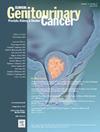在美国接受镭-223治疗的老年男性转移性前列腺癌患者的使用模式和生存率:一项SEER-Medicare研究
IF 2.7
3区 医学
Q3 ONCOLOGY
引用次数: 0
摘要
导读:先前关于转移性前列腺癌的镭-223治疗模式的研究仅限于选定部位、肿瘤实践或索赔数据库。关于镭-223在医疗保险人群(美国65岁及以上人群的最大公共保险提供者)中的使用和结果的数据有限。因此,本研究使用与医疗保险索赔相关的全国癌症登记人口数据库来检查Ra-223治疗模式、与治疗完成相关的因素及其与生存结果的关联。患者和方法:对2016年1月至2020年6月期间接受Ra-223治疗的1062名患有前列腺癌的医疗保险受益人(≥66岁)进行了回顾性队列分析。在Ra-223开始之前,符合条件的男性有12个月连续的医疗保险A/B/D部分登记,并至少随访6个月。主要结局包括完成≥5个周期的Ra-223治疗和总生存期。采用多变量logistic回归分析影响完成度的因素,采用Kaplan-Meier和比例风险回归估计生存率。结果:该队列为79.9%的非西班牙裔白人,6.8%的西班牙裔和6.1%的非西班牙裔黑人,平均年龄为75.6岁(SD = 6.6)。总体而言,59.4%完成≥5个疗程。接受Ra-223作为一线(21.1%)或二线转移性去势抵抗性前列腺癌(mCRPC)治疗的男性(44.1%)比接受三线或更晚治疗的男性更有可能完成治疗(aOR = 1.76,1.56, 95% CI,[1.22-2.54],[1.17-2.08])。完成≥5个周期的Ra-223治疗与更长的生存期相关(18.5个月vs 11.1个月,P < 0.001;aHR = 0.51, 95% CI,[0.44, 0.59]),一线或二线治疗使用也是如此(18.4个月,14.8个月对13.8个月,P < 0.001;aHR = 0.56,0.82;95% CI,[0.45-0.68],[0.69-0.96]),与Ra-233相比,在三线或更晚。结论:大多数男性接受≥5个周期的Ra-223治疗。早期开始使用Ra-223与更高的完成率和更好的生存结果相关,强调了早期使用Ra-223在治疗mCRPC中的重要性。本文章由计算机程序翻译,如有差异,请以英文原文为准。
Utilization Patterns and Survival in Older Men With Metastatic Prostate Cancer Treated with Radium-223 in the United States: A SEER-Medicare Study
Introduction
Previous research on Radium-223 treatment patterns in metastatic prostate cancer has been limited to select sites, oncology practices, or claims databases. Limited data exists on the use and outcomes of Radium-223 in Medicare population the largest public insurance provider for people aged 65 years and older in the United States. Therefore, this study used a nationwide population database of cancer registries linked to Medicare claims to examine Ra-223 treatment patterns, factors associated with treatment completion, and their associations with survival outcomes.
Patients and Methods
A retrospective cohort analysis was conducted on 1062 Medicare beneficiaries (≥ 66 years) with prostate cancer who initiated Ra-223 treatment between January 2016 and June 2020. Eligible men had 12 months of continuous Medicare Parts A/B/D enrollment prior to Ra-223 initiation and were followed for a minimum of 6 months. Primary outcomes included completion of ≥ 5 cycles of Ra-223 and overall survival. Factors influencing completion were analyzed with multivariate logistic regression, and survival was estimated using Kaplan-Meier and proportional hazards regressions.
Results
The cohort was 79.9% nonhispanic White, 6.8% Hispanic, and 6.1% nonhispanic Black, with a mean age of 75.6 years (SD = 6.6). Overall, 59.4% completed ≥ 5 cycles. Men receiving Ra-223 as first-line (21.1%) or second-line metastatic castration-resistant prostate cancer(mCRPC) therapy (44.1%) were more likely to complete treatment than those receiving third-line or later (aOR = 1.76,1.56, 95% CI, [1.22-2.54], [1.17-2.08]). Completing ≥ 5 cycles of Ra-223 was associated with longer survival (18.5 vs. 11.1 months, P < .001; aHR = 0.51, 95% CI, [0.44, 0.59]), as was first- or second-line therapy use (18.4, 14.8 months vs. 13.8 months, P < .001; aHR = 0.56,0.82; 95% CI, [0.45-0.68], [0.69-0.96]) compared to Ra-233 as third-line or later.
Conclusion
The majority of men received ≥ 5 cycles of Ra-223. Early initiation of Ra-223 was associated with higher completion rates and better survival outcomes, underscoring the importance of early Ra-223 use in managing mCRPC.
求助全文
通过发布文献求助,成功后即可免费获取论文全文。
去求助
来源期刊

Clinical genitourinary cancer
医学-泌尿学与肾脏学
CiteScore
5.20
自引率
6.20%
发文量
201
审稿时长
54 days
期刊介绍:
Clinical Genitourinary Cancer is a peer-reviewed journal that publishes original articles describing various aspects of clinical and translational research in genitourinary cancers. Clinical Genitourinary Cancer is devoted to articles on detection, diagnosis, prevention, and treatment of genitourinary cancers. The main emphasis is on recent scientific developments in all areas related to genitourinary malignancies. Specific areas of interest include clinical research and mechanistic approaches; drug sensitivity and resistance; gene and antisense therapy; pathology, markers, and prognostic indicators; chemoprevention strategies; multimodality therapy; and integration of various approaches.
 求助内容:
求助内容: 应助结果提醒方式:
应助结果提醒方式:


